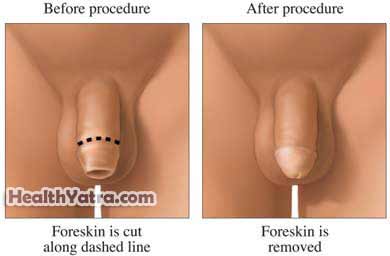Definition
Circumcision is the surgical removal of the foreskin. The foreskin is a flap of skin that covers the tip of the penis.

Reasons for Procedure
The procedure may be done for cultural or religious reasons. It is often done on babies in the first few days of life.
There may be some health benefits due to circumcision. Many health professionals believe these benefits are small. Circumcision may be associated with a decreased risk of:
- Urinary tract infection
- Phimosis (tightening of the foreskin)
- Penile cancer
- Certain sexually transmitted diseases, like HIV
- Cervical cancer in female partners
Possible Complications
Complications are rare. No procedure is completely free of risk. Talk to your doctor about possible complications that may include:
- Infection
- Bleeding
- Reaction to drugs used for anesthesia
- You may not be happy with the appearance of penis after circumcision
- Decreased penile sensation
- Damage to the tip of the penis
Factors that may increase the risk of complications include:
- Bleeding disorders
- Family history of bleeding disorders
- Birth mothers taking blood thinners during pregnancy
- Penile deformities whose foreskin may be needed to repair the deformity
- Prematurity
- Infections or serious jaundice at the time of the circumcision
What to Expect
Prior to Procedure
- The doctor will carefully examine your baby. This is to make sure your baby is in good health. The penis will be examined for any abnormalities.
- Blood and/or urine tests may be done.
- Your baby may be given a pacifier to suck on. The pacifier will have some sugar water on it. This has been shown to decrease pain in infants.
Anesthesia
The type of anesthesia may depend on where the circumcision is done. Two common approaches include:
- Cream—A cream may be applied to the penis. This cream will help to numb the area. It is often done about 60-90 minutes before the circumcision.
- Nerve block—This is a medication injected near the penis. The medication will block the nerve that runs to the penis. This will make the entire penis numb. It may be used in a hospital setting.
Description of the Procedure
The baby will need to be very still during the circumcision. The baby may be carefully restrained on an infant board or someone will hold the baby. The anesthesia will be applied.
Once the area is numb the doctor will begin. The foreskin will be pulled away from the penis. Some parts of the foreskin may still be attached to the penis. The doctor will sweep these attachments away. The extra foreskin will then be cut away. It can be removed a number of ways:
- A simple scalpel may be used.
- Special devices may be used. These devices make sure there is an even cut. The device also clamps the blood vessels. Examples of this device include the Gomco clamp, Plastibell device, or Mogen clamp.
Stitches may be needed. They will be used to sew the remaining bit of foreskin into place. Petroleum jelly or an antibiotic ointment will be smeared on the penis. A bandage may be applied. A Plastibell device, if used, will be left in place instead of a bandage. The Plastibell will fall off on its own.
How Long Will It Take?
About 15–30 minutes
Will It Hurt?
Your baby will have some discomfort. The anesthesia should minimize pain.
Post-procedure Care
After the procedure, be sure to follow your doctor’s instructions. Your doctor may ask you to:
- Change the bandage and clean the area at every diaper change.
- Apply petroleum jelly or an antibiotic ointment to the area. This will help keep the diaper or bandage from sticking to the penis.
There may be a lot of swelling of the penis. You may also notice a clear scab over the area. The penis should be healing well within 7-10 days of the circumcision. If a Plastibell was used, it should fall off on its own within 10 days.
Call Your Doctor
After arriving home, contact your doctor if any of the following occurs:
- You find a bloodstain larger than the size of a quarter on the baby’s diaper
- The Plastibell device has not fallen off within 10 days
- The penis or the area of the incision appears red, swollen, hot to the touch, or is oozing a yellowish discharge
- The baby develops a fever or appears to be in pain
- The baby does not have a wet diaper within 6–8 hours of the procedure
- The head of the penis appears blue or black
If you think you have an emergency, call for medical help right away.
